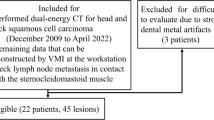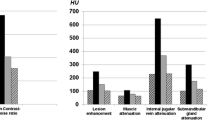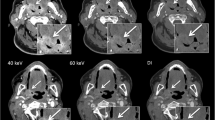Abstract
Introduction
To investigate low-tube-voltage 80-kVp computed tomography (CT) of head and neck primary and recurrent squamous cell carcinoma (SCC) regarding objective and subjective image quality.
Methods
We retrospectively evaluated 65 patients (47 male, 18 female; mean age: 62.1 years) who underwent head and neck dual-energy CT (DECT) due to biopsy-proven primary (n = 50) or recurrent (n = 15) SCC. Eighty peak kilovoltage and standard blended 120-kVp images were compared. Attenuation and noise of malignancy and various soft tissue structures were measured. Tumor signal-to-noise ratio (SNR) and contrast-to-noise ratio (CNR) were calculated. Subjective image quality was rated by three reviewers using 5-point grading scales regarding overall image quality, lesion delineation, image sharpness, and image noise. Radiation dose was assessed as CT dose index volume (CTDIvol). Interobserver agreement was calculated using intraclass correlation coefficient (ICC).
Results
Mean tumor attenuation (153.8 Hounsfield unit (HU) vs. 97.1 HU), SNR (10.7 vs. 8.3), CNR (8.1 vs. 4.8), and subjective tumor delineation (score, 4.46 vs. 4.13) were significantly increased (all P < 0.001) with 80-kVp acquisition compared to standard blended 120-kVp images. Noise of all measured structures was increased in 80-kVp acquisition (P < 0.001). Overall interobserver agreement was good (ICC, 0.86; 95 % confidence intervals: 0.82–0.89). CTDIvol was reduced by 48.7 % with 80-kVp acquisition compared to standard DECT (4.85 ± 0.51 vs. 9.94 ± 0.81 mGy cm, P < 0.001).
Conclusions
Head and neck CT with low-tube-voltage 80-kVp acquisition provides increased tumor delineation, SNR, and CNR for CT imaging of primary and recurrent SCC compared to standard 120-kVp acquisition with an accompanying significant reduction of radiation exposure.


Similar content being viewed by others
References
Hermans R (2006) Staging of laryngeal and hypopharyngeal cancer: value of imaging studies. Eur Radiol 16:2386–2400
Sadick M, Schoenberg SO, Hoermann K, Sadick H (2012) Current oncologic concepts and emerging techniques for imaging of head and neck squamous cell cancer. GMS Curr Top Otorhinolaryngol Head Neck Surg 11:Doc08
Url C, Schartinger VH, Riechelmann H et al (2013) Radiological detection of extracapsular spread in head and neck squamous cell carcinoma (HNSCC) cervical metastases. Eur J Radiol 82:1783–1787
Toepker M, Czerny C, Ringl H et al (2014) Can dual-energy CT improve the assessment of tumor margins in oral cancer? Oral Oncol 50:221–227
Tawfik AM, Kerl JM, Bauer RW et al (2012) Dual-energy CT of head and neck cancer: average weighting of low- and high-voltage acquisitions to improve lesion delineation and image quality-initial clinical experience. Investig Radiol 47:306–311
Scholtz JE, Husers K, Kaup M et al (2014) Non-linear image blending improves visualization of head and neck primary squamous cell carcinoma compared to linear blending in dual-energy CT. Clin Radiol. doi:10.1016/j.crad.2014.10.018
Paul J, Mbalisike EC, Nour-Eldin NE, Vogl TJ (2013) Dual-source 128-slice MDCT neck: radiation dose and image quality estimation of three different protocols. Eur J Radiol 82:787–796
Tawfik AM, Razek AA, Kerl JM, Nour-Eldin NE, Bauer R, Vogl TJ (2014) Comparison of dual-energy CT-derived iodine content and iodine overlay of normal, inflammatory and metastatic squamous cell carcinoma cervical lymph nodes. Eur Radiol 24:574–580
Vogl TJ, Schulz B, Bauer RW, Stover T, Sader R, Tawfik AM (2012) Dual-energy CT applications in head and neck imaging. AJR Am J Roentgenol 199:S34–39
Macari M, Spieler B, Kim D et al (2010) Dual-source dual-energy MDCT of pancreatic adenocarcinoma: initial observations with data generated at 80 kVp and at simulated weighted-average 120 kVp. AJR Am J Roentgenol 194:W27–32
Nakaura T, Awai K, Oda S et al (2011) Low-kilovoltage, high-tube-current MDCT of liver in thin adults: pilot study evaluating radiation dose, image quality, and display settings. AJR Am J Roentgenol 196:1332–1338
Nakayama Y, Awai K, Funama Y et al (2005) Abdominal CT with low tube voltage: preliminary observations about radiation dose, contrast enhancement, image quality, and noise. Radiology 237:945–951
Kanematsu M, Goshima S, Miyoshi T et al (2014) Whole-body CT angiography with low tube voltage and low-concentration contrast material to reduce radiation dose and iodine load. AJR Am J Roentgenol 202:W106–116
Xia W, Wu JT, Yin XR, Wang ZJ, Wu HT (2014) CT angiography of the neck: value of contrast medium dose reduction with low tube voltage and high tube current in a 64-detector row CT. Clin Radiol 69:e183–189
Zhang WL, Li M, Zhang B et al (2013) CT angiography of the head-and-neck vessels acquired with low tube voltage, low iodine, and iterative image reconstruction: clinical evaluation of radiation dose and image quality. PLoS One 8:e81486
Gnannt R, Winklehner A, Goetti R, Schmidt B, Kollias S, Alkadhi H (2012) Low kilovoltage CT of the neck with 70 kVp: comparison with a standard protocol. AJNR Am J Neuroradiol 33:1014–1019
Hoang JK, Yoshizumi TT, Nguyen G et al (2012) Variation in tube voltage for adult neck MDCT: effect on radiation dose and image quality. AJR Am J Roentgenol 198:621–627
May MS, Kramer MR, Eller A et al (2014) Automated tube voltage adaptation in head and neck computed tomography between 120 and 100 kV: effects on image quality and radiation dose. Neuroradiology 56:797–803
Wichmann JL, Kraft J, Noske EM et al (2014) Low-tube-voltage 80-kVp neck CT: evaluation of diagnostic accuracy and interobserver agreement. AJNR Am J Neuroradiol 35:2376–2381
Tawfik AM, Kerl JM, Razek AA et al (2011) Image quality and radiation dose of dual-energy CT of the head and neck compared with a standard 120-kVp acquisition. AJNR Am J Neuroradiol 32:1994–1999
Paul JF (2011) Individually adapted coronary 64-slice CT angiography based on precontrast attenuation values, using different kVp and tube current settings: evaluation of image quality. Int J Cardiovasc Imaging 27(Suppl 1):53–59
Yeh BM, Shepherd JA, Wang ZJ, Teh HS, Hartman RP, Prevrhal S (2009) Dual-energy and low-kVp CT in the abdomen. AJR Am J Roentgenol 193:47–54
Kayan M, Koroglu M, Yesildag A et al (2012) Carotid CT-angiography: low versus standard volume contrast media and low kV protocol for 128-slice MDCT. Eur J Radiol 81:2144–2147
Bamberg F, Dierks A, Nikolaou K, Reiser MF, Becker CR, Johnson TR (2011) Metal artifact reduction by dual energy computed tomography using monoenergetic extrapolation. Eur Radiol 21:1424–1429
Toepker M, Moritz T, Krauss B et al (2012) Virtual non-contrast in second-generation, dual-energy computed tomography: reliability of attenuation values. Eur J Radiol 81:e398–405
Ethical standards and patient consent
We declare that all human and animal studies have been approved by the Ethics Committee of the University Hospital of Frankfurt/Main and have therefore been performed in accordance with the ethical standards laid down in the 1964 Declaration of Helsinki and its later amendments. Due to the retrospective nature of this study, informed consent was waived.
Conflict of interest
RWB and JMK are on the Siemens Healthcare Computed Tomography Division Speakers’ Bureau. However, neither author analyzed or controlled any data in this study.
Author information
Authors and Affiliations
Corresponding author
Rights and permissions
About this article
Cite this article
Scholtz, JE., Kaup, M., Kraft, J. et al. Objective and subjective image quality of primary and recurrent squamous cell carcinoma on head and neck low-tube-voltage 80-kVp computed tomography. Neuroradiology 57, 645–651 (2015). https://doi.org/10.1007/s00234-015-1512-x
Received:
Accepted:
Published:
Issue Date:
DOI: https://doi.org/10.1007/s00234-015-1512-x




